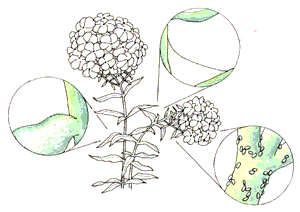 |
Spindly, Leggy Plants Caused ByNot Enough Sun
Phlox need lots of direct, bright sun to flourish. If they are shaded, they are forced to stretch to reach the light, causing them to develop thin stems. Trim away nearby overgrowth that may be blocking their access to light. Transplant them to a sunnier spot as a last resort.
Blooming Stops Because Plant Has Set Seed
It is important to snip off the faded flower heads from phlox stems promptly. If the flowers begin to develop into seeds, the plant will no longer produce flowers, since its life cycle has been completed.
Leaves Curled And Distorted Caused By Aphids
Aphids, also called "plant lice," are soft-bodied, pear-shaped sucking insects about the size of the head of a pin. They often cluster gather in large groups of wingless and winged forms on leaves and tender buds. Their feeding retards plant growth. Phlox leaves may turn yellow or brown. They wilt under bright sunlight, or sometimes curl and pucker. Spray the insects with insecticidal soap every 3 to 5 days. If that doesn't work, try pyrethrum every 5 to 7 days. Be sure to read and follow the directions on the label of all pesticide products. Do not over-fertilize plants. For more information see the files on Controlling Aphids
Flowers Deformed By Phlox Plant Bugs
Adult phlox plant bugs are reddish-orange, with a black stripe running down their back. Adults and nymphs sting flower buds, causing them to be deformed. They also suck plant sap from tender leaves and buds, producing light spots and distorted growth. The eggs, laid on leaf stalks, hatch in May. Spray the pests with pyrethrum, taking care to follow label directions. Cut and discard dead growth and plant debris after the first frost to eliminate overwintering eggs. For more information see the file on Controlling Plant Bugs
Leaves Discolored, Webbed Over By Spider Mites
Spider mites are about 1/50 inch long, barely visible to the unaided eye. They're not true insects, but are related to spiders, with four pairs of legs, piercing-sucking mouth parts, and very compact bodies. They may be yellow, green, red or brown. Inspect the lowest leaves on your plant. Upper leaf surfaces stippled with small yellow dots or red spots suggests the presence of mites. Leaves and adjacent stems may be distorted or covered with fine webs. Mites are most abundant in late summer's hot, dry weather. Start control measures as soon as you notice the first stippling of the leaves. Spray the pests with insecticidal soap every 3 to 5 days for 2 weeks. Read and follow the instructions on the product label. For more information see the file on Controlling Mites
Leaves Riddled With Holes From Flea Beetles
Flea beetles are shiny, black or brown, sometimes with yellow or white markings. They're 1/10 inch long and very active, jumping like fleas when disturbed. The pests attack younger plants, perforating their leaves with dozens or hundreds of tiny holes. They also transmit viral and bacterial diseases, including early blight or bacterial wilt. Repel beetles in early spring by covering plants with agricultural fleece, also known as "floating row cover." Dust visible pests with pyrethrum or rotenone at 3 to 5 day intervals until they disappear. Read and follow the instructions on pesticide product labels. For more information see the file on Controlling Flea Beetles
Leaves Covered With White From Powder,Powdery Mildew
Powdery mildew is caused by fungi that live on the surface cells of a plant, coating infected leaves with a white or ash-gray powdery mold. Badly infected lower leaves become discolored and distorted, then (drop)off. It is the most common disease problem of phlox. The disease is encouraged by crowding and by warm, humid weather. It is unsightly, but rarely kills the plant. Spray plants thoroughly with wettable sulfur every 2 weeks, starting as soon as the whitish coating of the fungus appears. Read and follow the instructions on the product label. Allow ample spacing between plants for good air circulation and try to avoid wetting the foliage when watering. Collect and discard all aboveground refuse in the fall. For more information see the file on Controlling Fungal Disease
Leaves Spotted Or Blotched From Fungal Leaf Spots
Many kinds of leaf spots are caused by fungi that thrive on moist leaf surfaces and cause transparent to brown or black spots that disfigure the leaves. Some fungal spots are surrounded by flecks or black dots, their spore-bearing fruiting bodies. Often spots come together to form larger patches of dead tissue. Pick off and discard infected leaves. Remove dead plant debris promptly from the garden to reduce overwintering spore populations. Dig up and discard seriously infected plants together with the soil of their root ball. Mulching helps prevent splash-borne infection in outdoor plantings. Spray at weekly to 10 day intervals with wettable sulfur or Bordeaux mixture, particularly in wet weather. (Watch for leaf discoloration with the latter). Read and follow the directions on the product label. For more information see the file on Controlling Fungal Disease
Plants Eaten By Rabbits
Although rabbits are active throughout the year, their attacks on the garden reach their height during the summer. The only effective control for rabbits is a barrier of some kind. While vegetable beds can be effectively protected with a 1 1/2 inch mesh chicken wire fence, anchored firmly to the ground and strung 2 to 3 feet high, this is not feasible for ornamental plants such as phlox. Most homeowners find that a dog or cat on patrol in the yard is the best control measure for rabbits. See the file on Dealing With Rabbits

